
Hillmans Airways
Hillman Airways was founded by Edward Henry Hillman who during the course of a comparatively short but eventful life, rose from the humblest
beginnings to become not only the proprietor of the world’s largest privately-owned bus fleet, but also a substantial airline. The company was formed
on 26th November 1931 as Hillman's Saloon Coaches and Airways Limited. They flew out of a small airfield in Essex between Brentwood and Romford
called Maylands. From 1 December 1934, the airline was given a contract to fly air mail between London, Liverpool, Glasgow and Belfast formerly
operated by the Railway Air Services. On 1 June 1934, the airline moved its operating base from Maylands Aerodrome to Stapleford Aerodrome, Essex.
In October 1935 it merged with Spartan Airways and United Airways to form British Airways. The company issued no official envelopes for its first flight
although it did approve an envelope designed and printed by the Liverpool stamp dealer John Davis. The covers are made of wove paper and show a
map of Great Britain with a large airplane superimposed. Both are in blue. 961 of these envelopes were flown. Pilot signed covers are numerous and
they are not always signed by the pilot that flew the plane! The London to Glasgow flight was flown by Capt. W Anderson and the other way by Capt.
C.E.N. Pelly. The contract expired on 30 Nov 1935 and awarded once more to R.A.S. Most of the envelopes seen for Hillman Airways are for the first
flight of the air mail contract starting on 1st November 1934. There are three types of first day covers, plain envelopes, the Davis covers printed by
Liverpool dealer John S. Davis, another dealer A. Philips produced an envelope with a different coloured plane depending on the starting point.
Hillman Airways. First Flight of new London to Glasgow mail contract. 1st December 1934.
Hillman Airways took over from RAS for the London to Glasgow mail contract on 1st December 1934. The route was different from the RAS route. There were only two stops now between London and Glasgow, Liverpool and Belfast. Flights originated in Glasgow where the daily plane left at 8.30 am it left Belfast at 9.30, left Liverpool 10.45 and arrived London at 12.05. A different plane went on the route to Glasgow, it did not wait for the plane flying down. It left Stapleford Airport at 10.00 am, left Liverpool at 11.20 and left Belfast at 12.35 arriving Glasgow at 1.35 pm.The GPO Announces the service.
Copyright
© 2022 Robert Farquharson All Rights Reserved

British Internal Airmails of the 1930’s

Black ‘busy’ Davis envelope proof in black. Various
comments in pencil show the future intention. ‘1000
required Blue’ shows the number required and the colour.
‘250 wanted Wed’ shows 250 were required on the 28th.
The purple date cachet shows the date this was sent to
Davis. ‘Mr Davis’ is the clients name. ‘Order No C14 is self
explanatory. The writing under the map which was printed
as ‘BY HILLMAN AIRMAIL LTD’ has been corrected to ‘BY
HILLMAN AIRWAYS LTD.

The final mint version as produced.
Davis Covers
The Liverpool dealer John Davis had 1000 envelopes printed with a dark blue picture of a plane over a map of Great Britain. Apparently 950 of these were flown. This would have left 50 mint envelopes, but mint envelopes are quite scarce so the number may not have been that high. The timescale for the production of these envelopes is not known, but it may have been quite tight as seen from a proof envelope shown below which was sent to Davis for approval on the 28th November.

Glasgow to London
Belfast to Liverpool.
Belfast to London
Liverpool to London
Glasgow to Belfast. Pilot signed.
Glasgow to Liverpool.
Pilot signed.
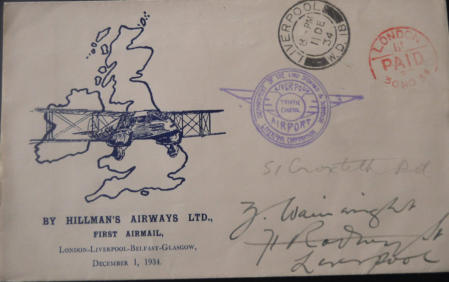
London to Liverpool
London to Belfast
Glasgow to London. Pilot signed.
Belfast to Liverpool. Pilot signed.
Belfast to London
Liverpool to London. Pilot signed.

London to Liverpool. Pilot signed.
London to Belfast. Pilot signed.
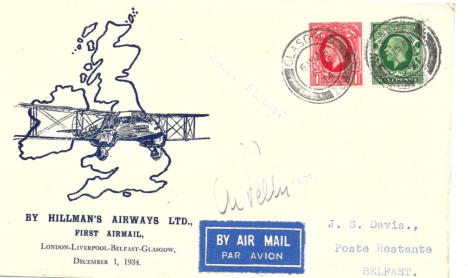






London to Glasgow Pilot signed.
Liverpool to Belfast. Philips cover.
Philips cover. Belfast to Glasgow

London to Glasgow Pilot signed.
Liverpool to Belfast. Pilot signed.



Phillips Covers
Phillips produced different envelopes depending on where the cover started.


Philips cover. Liverpool to Belfast.
Phillips cover. London to Belfast

Other First Flight Covers


Business reply Service. Belfast to Liverpool
Pitman cover. Glasgow to Belfast.
Glasgow receiving cachets.
On 2nd February, 1935, during the operation of the mail-carrying services of Hillman’s AIrways Ltd, to and from Glasgow, the Postmaster-Surveyor at Glasgow introduced the plan of applying a special cachet to incoming air amil in order to popularize the internal air service. The scheme was short lived but during it operation four types of cachet were employed.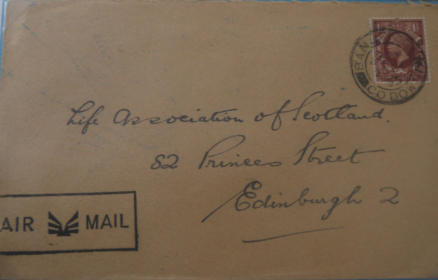

Type 1 cachet. Solid Wings.
Type 2 cachet. Hollow Wings.
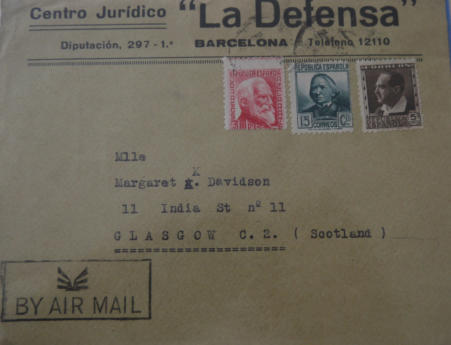
Type 3 cachet. Solid Wings. ‘BY’ added
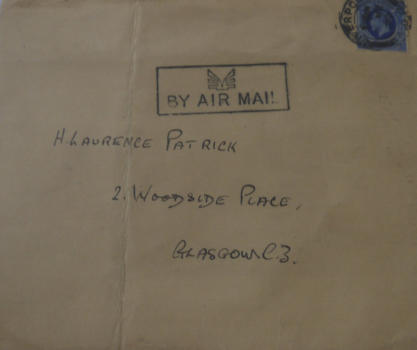
Type 4 cachet. Hollow Wings. ‘BY’ added

On March 1935 the authorities considered it advisable to
alter the wording of the type one cachet by adding the
word BY this alteration became known as type three. These
dies were affixed into the cancelling machine without the
date and time section, thus the mail had to go through two
machines prior to being sorted. It transpired that on one
day the ink pad had not been changed and a very few
examples were stuck with a RED impression.


Unusual usage. Dublin to Glasgow
The Glasgow cachets had finished by the end
of the Hillman’s cachet on the 1st December
1935. It is not known how this cachet of the
27th August 1936, got through the system.
Philips cover. Glasgow to Belfast
Other Flights

Glasgow to London. Large Essex Cachet.
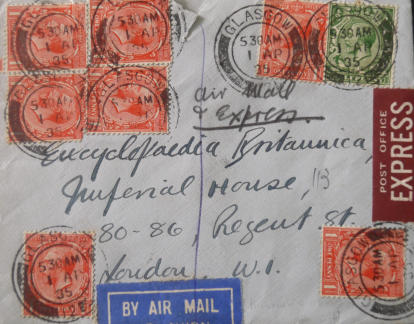
Glasgow to London. Express.
Airport Cachets and Last Flights

Last flight Glasgow to Belfast Nov 30th 1935

Last flight Belfast to London Nov 30th 1935
Baggage Labels
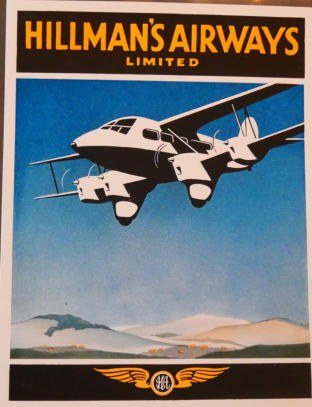

Liverpool to Glasgow Pilot signed.
Belfast to Glasgow Pilot signed.

Hillmans Airways
Hillman Airways was founded by Edward Henry Hillman who during the course of a comparatively short but eventful life, rose from the humblest
beginnings to become not only the proprietor of the world’s largest privately-owned bus fleet, but also a substantial airline. The company was formed on
26th November 1931 as Hillman's Saloon Coaches and Airways Limited. They flew out of a small airfield in Essex between Brentwood and Romford called
Maylands. From 1 December 1934, the airline was given a contract to fly air mail between London, Liverpool, Glasgow and Belfast formerly operated by
the Railway Air Services. On 1 June 1934, the airline moved its operating base from Maylands Aerodrome to Stapleford Aerodrome, Essex. In October
1935 it merged with Spartan Airways and United Airways to form British Airways. The company issued no official envelopes for its first flight although it
did approve an envelope designed and printed by the Liverpool stamp dealer John Davis. The covers are made of wove paper and show a map of Great
Britain with a large airplane superimposed. Both are in blue. 961 of these envelopes were flown. Pilot signed covers are numerous and they are not
always signed by the pilot that flew the plane! The London to Glasgow flight was flown by Capt. W Anderson and the other way by Capt. C.E.N. Pelly. The
contract expired on 30 Nov 1935 and awarded once more to R.A.S. Most of the envelopes seen for Hillman Airways are for the first flight of the air mail
contract starting on 1st November 1934. There are three types of first day covers, plain envelopes, the Davis covers printed by Liverpool dealer John S.
Davis, another dealer A. Philips produced an envelope with a different coloured plane depending on the starting point.
Hillman Airways. First Flight of new London to Glasgow mail contract. 1st December 1934.
Hillman Airways took over from RAS for the London to Glasgow mail contract on 1st December 1934. The route was different from the RAS route. There were only two stops now between London and Glasgow, Liverpool and Belfast. Flights originated in Glasgow where the daily plane left at 8.30 am it left Belfast at 9.30, left Liverpool 10.45 and arrived London at 12.05. A different plane went on the route to Glasgow, it did not wait for the plane flying down. It left Stapleford Airport at 10.00 am, left Liverpool at 11.20 and left Belfast at 12.35 arriving Glasgow at 1.35 pm.The GPO Announces the service.

Glasgow to London
Belfast to London
Glasgow to Belfast. Pilot signed.

London to Liverpool

London to Glasgow Pilot signed.
Copyright
© 2020 Robert Farquharson All Rights Reserved
Philips cover. Belfast to Glasgow
Other flights.
Glasgow to London. Large Essex Airport cachet
Airport Cachets and Last Flights

Last flight Glasgow to Belfast Nov 30th 1935
Glasgow receiving cachets.
On 2nd February, 1935, during the operation of the mail-carrying services of Hillman’s AIrways Ltd, to and from Glasgow, the Postmaster-Surveyor at Glasgow introduced the plan of applying a special cachet to incoming air amil in order to popularize the internal air service. The scheme was short lived but during it operation four types of cachet were employed.

Type 1 cachet. Solid Wings.

Type 3 cachet. Solid Wings. ‘BY’ added


British Internal Airmails of the 1930’s
Glasgow to London. Pilot signed.
Belfast to London

London to Liverpool. Pilot signed.

London to Glasgow Pilot signed.
































